| 077
|
CHAPTER 10
A Wheelchair Seat Helps Dora
Overcome Chronic Depression
DORA is a school teacher from Guadalajara, in her
mid-30s. Until she was about 25 years old, she was energetic and full of
life. Then she began to develop muscle weakness and spasticity first in her
legs, then in her whole body. Diagnosed as multiple sclerosis,
it was at first only a nuisance; then it became disabling. For a while, she
used a wheelchair. But a huge pressure sore formed on her left buttock.
After that, she had to remain in bed. Her health worsened until she was very
thin and pale. Doctors said her condition was too delicate to risk surgery
to close the sore. Despite medical attention, counseling, and a supportive
family, her condition continued to worsen. At last - on an off chance - her
mother took her to PROJIMO, 300 miles away.
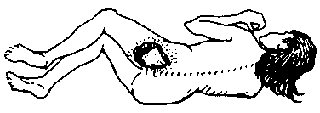
When Dora arrived, the PROJIMO team welcomed her and did their best to
respond to her needs. By then, her physical condition was life-threatening.
The huge pressure sore had destroyed all the skin and flesh of one buttock,
leaving the entire butt-bone (ischial tuberosity) exposed.
Long-term infection and oozing from the sore had left Dora severely
anemic and protein deficient. But, her state of mind was even more critical
than her physical condition. Dora was deeply and chronically depressed. She
had spent most of the last 4 years, day and night, lying in a bed in her
parents' home. Her doctors had forbidden her to sit in a wheelchair, or even
to sit up in bed, because of the enormous pressure sore on her buttock.
First Steps
On talking with Dora and her mother, Mari realized that, in order to
improve her condition, one of the first tasks was to help her to overcome
her depression.
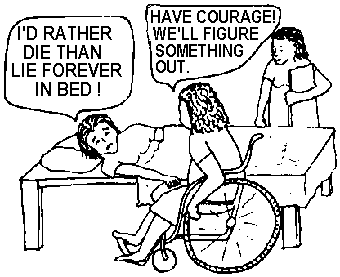
"I don't want to go on living if I have to spend the rest of my life
cooped up and lying in bed." Dora said. "But the doctors say I have no
choice. They tell me I have to get stronger before they can operate on my
buttock. But I just keep getting weaker!"
Dora looked at Mari with tears in her eyes. "If I could only move about
like you do in a wheelchair! Then I could go outside, visit friends, do lots
of things!"
"Have courage!" said Mari. "Together we'll do our best to figure
something out."
Mari and the PROJIMO team met with Dora and her mother to look for
solutions. To improve her physical health, she would need an iron-, energy-,
and protein-rich diet. But she was so unhappy that she ate almost nothing.
Everyone agreed that, for Dora to improve physically, it was important for
her to improve her feelings about herself and her life. She needed a renewal
of hope - and a sense that life was worth living.
Dora's first wish was to get out of bed and move about: in other words,
mobility. But how was this possible with the giant lesion
on her buttock? "Her sore will never heal with her lying on it. She's too
weak for surgery, and she's so unhappy that her overall health keeps
deteriorating," said Mari. "What to do?" |
| 078 |
The Gurney That Didn't Help
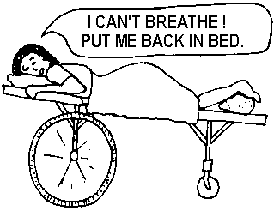
One idea the team had was to arrange for Dora to lie face-down on a
wheeled cot, or gurney (trolley). They have used gurneys for many
spinal-cord injured persons with pressure sores. Lying face-down takes the
pressure off the sores. Also, actively moving about on a gurney can lift
people's spirits, improve circulation, and speed healing. (See Chapters
37 and 38.)
Dora was eager to try. But, lying on her stomach proved uncomfortable
because of her spasticity and contractures. Also, as severely anemic as
she was, she had trouble breathing. Struggling for air and soaked in
sweat, she begged sadly, "Put me back in bed."
After this failed attempt, Dora was more discouraged than ever. Her
mother was ready to take her back to Guadalajara. Another meeting was
held. Dora kept repeating her wish: "If only I could move about in a
wheelchair!"
An Unusual Wheelchair Seat
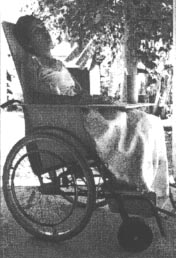 |
Impossible as it seemed, the team set about designing
a wheelchair for Dora that would put no pressure on the
buttock with the sore. Mario - who has had severe pressure
sores himself (see page 157) - built a
plywood seat to fit inside a standard PROJIMO-built Whirlwind
wheelchair. The plywood frame helped to hold her legs and feet in a
good position. |
|
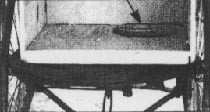
A large hole
was cut in the plywood seat to fit directly under Dora's destroyed
buttock, so that air could freely circulate to the bandaged sore.
Mario made a special cushion out of
layers of cardboard (see page 157). He
also put a hole in the cushion under the left buttock. |
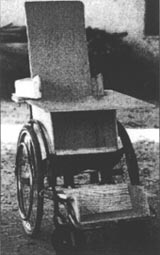
The sides of the seat extended far enough
forward so that padding could be placed to help Dora sit
upright, even with all her weight on one buttock only. |
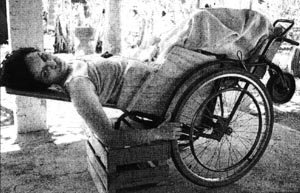
The high seat-back holds up Dora's
head when the chair is tilted back. This way, her chair can be
tilted far back at frequent intervals. This is essential to
prevent new pressure sores on the healthy hip, which supports her full
weight when seated. |
|
| 079
|
| "It works!" Dora tried the
new seat and was enthusiastic. It took some time to arrange padding next
to her thighs and flanks so that she could sit fairly straight and
comfortably. To protect the healthy buttock, the chair had to be tilted
back for a while every 10 or 15 minutes. With the basic chair completed,
Dora and the team began to look for ways to help her to function better.
They equipped the seat with a removable table so that she could read and
write, do manual activities, and feed herself.
However, feeding herself and drinking from a glass was a problem. The
combination of spasticity, weakness, and the tremor of her arm made it
hard to lift food or drink to her mouth without missing her mouth or
spilling it.
An Elbow Stabilizer to Facilitate Eating and Drinking
Inez (who assists people with physical and occupational therapy) helped
Dora to experiment with different devices and positions to make eating and
drinking easier. Dora found that when Inez held her elbow firmly on the
back corner of the table, she had more control. So the next job was to
figure out a simple way to stabilize her elbow without someone having to
hold it in place.
In the garbage bin, Inez found a small, broken, foam-plastic packing
box, with an inside width of about 3 inches (10 cm). With a pocket knife,
he fashioned the box to fit around Dora's elbow. He attached it with
Velcro (self-sticking but removable tape) to the back corner of Dora's
wheelchair table.
By inserting her elbow in the foam-plastic box attached to her table,
Dora found she could eat more easily and even drink without much spilling.
She was delighted, It was the first time in 4 years that she had been able
to eat and drink without assistance.
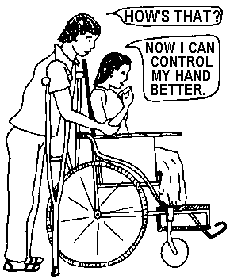
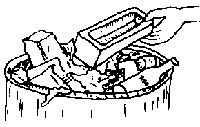
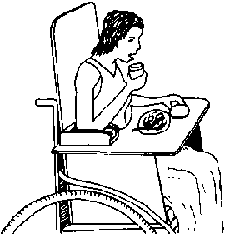
Not Her Sore, but rather Her Spirit was Healed
Dora and her mother stayed at PROJIMO for several weeks. By the time
she left she was eating better, gaining weight, and looking healthier. She
felt much more positive about her own existence. The pressure sore had not
even begun to heal, and probably never would without extensive surgery.
However, if Dora's health continues to improve, surgery at some time may
be possible.
But something more important than healing the sore was the healing of
her spirit. Her mother said that she was again beginning to see some of
the old spark and joy of life that had made Dora such a good teacher.
First things first.
_____________________________
NOTE: For innovative ideas on prevention and treatment of
pressure sores, see Chapters 27,
28 and 38.
For overall basic information on pressure sores, see the book,
Disabled Village Children, by David Werner. |
| 080
|
|
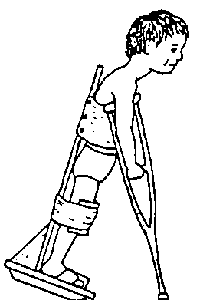
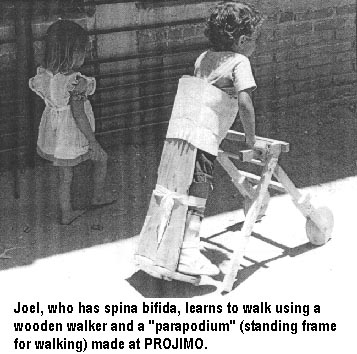
|
|